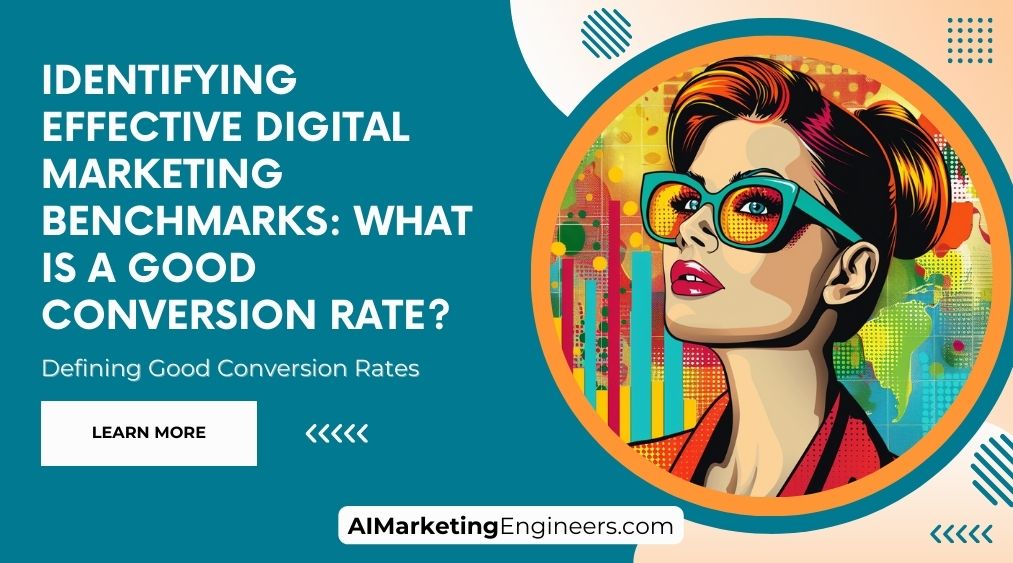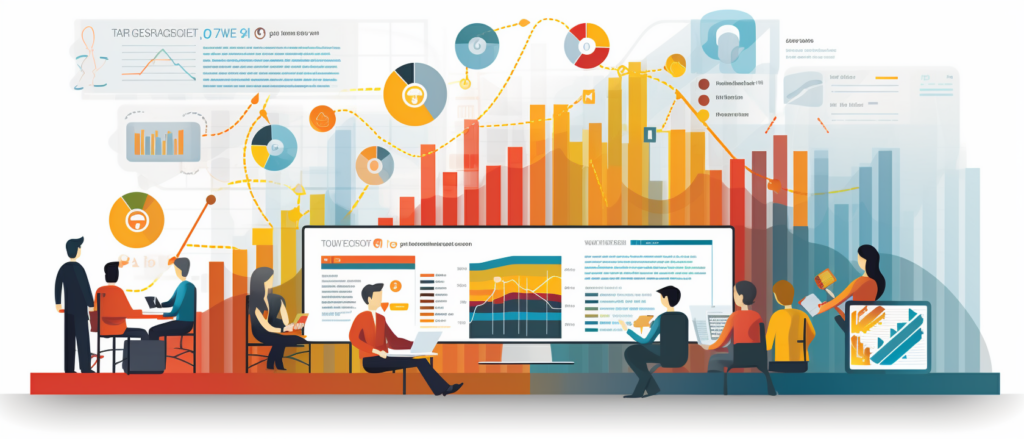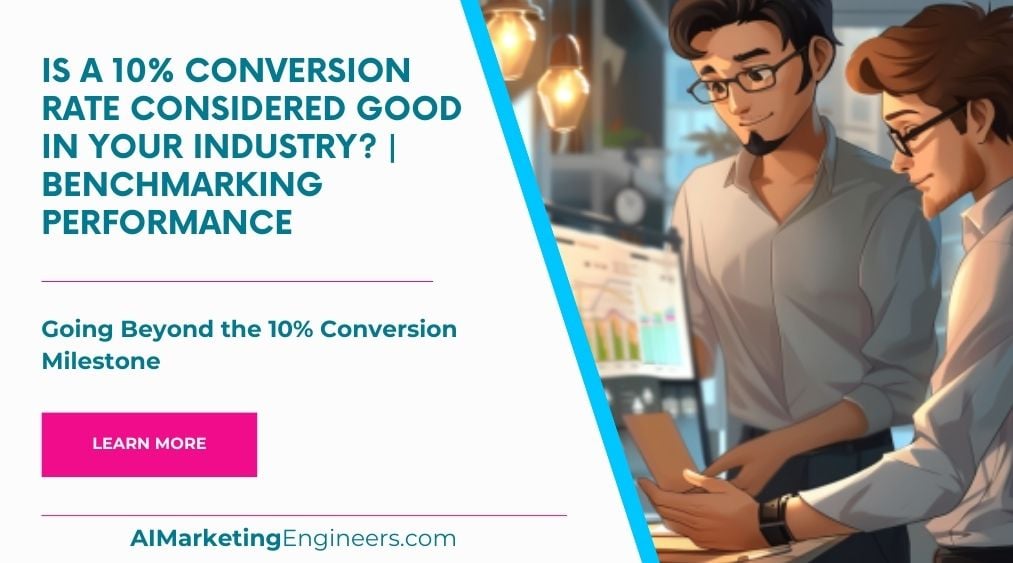Key Takeaways
✅ Conversion rates vary across industries and can greatly influence the measure of your campaign's success. It's true, what's considered "good" could be vastly different whether you're selling custom T-shirts or offering legal consulting. Average conversion rates are merely starting points—we're talking 2.35% across the board, with online stores hitting around 1.81%.
✅ While pinpointing an industry average can set the stage, it's just the warm-up act. Imagine using those numbers—let's say, a 1.81% average for e-commerce—as your starting line. Your job, from there, is to sprint ahead; not just by a smidge, but through strategic A/B testing, detailed analysis of user action, and always keeping the gears of optimization turning.
✅ Continuous optimization and testing, this isn't a one-and-done situation. It's an ongoing marathon. If you're not assessing, tweaking, and testing every corner of your campaign, from the user experience to your call-to-actions, you might as well throw in the towel now. Tools, data, and a hearty dose of curiosity will be your best friends, helping you refine that journey for your customers.

Introduction
Ever wonder if there's a magic number for your digital marketing efforts? A secret code that unlocks limitless potential for clicks, customers, and cash flow? Let's get real—searching for the ideal conversion rate is like finding a needle in a haystack. But fear not! We're here to sift through the digital strands with you; to find that sweet spot where every click could turn into a chorus of ringing cash registers.
From the dizzying heights of digital marketing's elite to the bustling markets of e-commerce and bespoke software services, you'll get the insider's peek at industry benchmarks and personal victories. Think of this article as your trusty compass, guiding you through the stormy seas of data towards the calm harbor of conversion rate optimization. Ready to levitate above the average and reach for the stars? Then follow us as we unravel the golden threads of marketing mastery that promise to push your numbers to new heights.
Top Statistics
| Statistic | Insight |
|---|---|
| Average Conversion Rates by Industry: General average is 2.35%, with top performers hitting above 5.31%. | Knowing these numbers helps you gauge where your business stands - are you keeping up, leading, or in need of a tweak in strategy? |
| Mobile Conversion Rates: Smartphones at 1.81% and tablets at 3.31%. | With more folks shopping on their phones, this is a wake-up call to make sure your mobile experience is as smooth as silk. |
| User Demographics and Conversion Rates: Users aged 45-54 lead with 3.04% conversion rates. | Age matters when you're talking about who's hitting the 'buy' button. Makes you think, who are you tailoring your content for? |
| Landing Page Conversion Rates: Average rate is 9.7%, top companies reach 11.45%. | Your landing page is like your storefront window. Is it compelling enough to pull people in off the digital sidewalk? |
| Industry Forecasts and Conversion Rates: E-commerce to hit $5.4 trillion in sales in 2022, major role by mobile devices. | Big numbers, right? This trend is your golden ticket to plan for more sales, especially on mobile. |
Understanding Conversion Rates in Digital Marketing
Ever wondered why everyone's buzzing about conversion rates? It's like you've baked this amazing cake (your website or campaign), and that moment someone takes a bite (I mean, takes an action you want), that's a conversion. In digital marketing, this rate is a big deal because it tells you the percentage of visitors doing what you hope they'd do. Could be buying, signing up, you name it.
The What and Why of Factors Affecting Conversion Rates
Imagine walking into a store that's a hot mess, chances are you'll walk right out, right? The same applies to a website. A user-friendly website design and a smooth user experience are key to keeping people interested. And the crowd you're bringing in? They've got to be the right fit. That's your target audience. The path to conversion is also paved with how you chatter away with your audience, be it via email, social media or good old ads. Catchy lines and clear calls-to-action can be those sweet whispers that encourage folks to click 'Buy now' or 'Sign up here'.
Peeking at Industry Benchmarks and Averages
Like in sports, knowing what a good score looks like is vital. Industry benchmarks serve up this insight. For example, if you're running an online store, you'd want to know what a good batting average is for e-commerce conversion rates, right? SaaS or B2B probably have different numbers to hit. Getting a sense of these averages helps you not shoot in the dark when striving for that touchdown.
Setting Realistic Conversion Rate Goals
Setting goals is like setting up a ladder – you want it to be high, but still reachable. To do that, go detective on your historical data and keep tabs on your competitors. What's working for them might just work for you. But remember, this isn't a set-it-and-forget-it; it's more like watering a plant. You've got to keep tracking and tweaking to see growth.
Advanced Conversion Rate Optimization Strategies
Ready to go pro? Techniques like A/B testing and hot-as-coal heatmaps can help you pinpoint exactly where your website is sizzling and where it's just lukewarm. Plus, ever thought about asking your users directly what they think? User feedback is golden. Also, wielding analytics tools like a wizard, you can spot your star pages, and those that might need a bit of magic dust.
The Importance of Continuous Improvement
Think of optimization as tuning a guitar. It's all about fine-tuning till the melody (conversion rate) is just right, and like a melody, it can always be improved. The trick is – don't rest on your laurels. Even small changes can make your revenue music sheets look way more impressive, and your ROI sing a happier tune.
So there you go! Which strategies are you going to pluck out and try? How will you tweak and fine-tune your site to hit all the right notes? Now's the time to grab that guitar and start strumming towards a chart-topping conversion rate.
AI Marketing Engineers Recommendation
Recommendation 1: Embrace Industry-Specific Conversion Rate Averages to Set Realistic Goals: Dig into the numbers! Based on the variety of industries out there, a "good" conversion rate can range from 1% to 3% in general e-commerce to as high as 5% to 10% in more niche markets. Get hold of conversion data related to your specific industry and use that as a benchmark. If you're selling handcrafted watches, you might not aim for the same numbers as someone hawking fast fashion. Adjust your expectations to the turf you’re playing on.
Recommendation 2: Optimize for Mobile to Capture a Growing Audience: Now, let's talk about keeping up with the times. With mobile commerce on the rise, your website and ads better be giving users a slick experience on their phones. Reports show that in 2021, over half of all internet shopping happened on mobile devices. Make sure your mobile conversion rates are keeping pace—if they're lagging behind the desktop numbers, you might need to polish up that mobile interface. Are you making it easy as pie for smartphone users to find what they need and check out? Think about it.
Recommendation 3: Leverage A/B Testing to Continuously Improve Conversion Rates: Ever tried on two outfits to see which looks better? That's the spirit of A/B testing for your website. Here’s the playbook: take two versions of a webpage or ad, change up a single element—a headline, image, or call to action—then see which one works better with your audience. Use tools like Google Optimize or Optimizely to run your tests. Give your audience the steering wheel and let their actions tell you what drives conversions. This is about finding what sings to your customers, not just throwing spaghetti at the wall to see what sticks.
Relevant Links
- Maximize Earnings with Affiliate Marketing: 2024's Insider Strategies
- AI-Driven SEO: Revolutionize Your Marketing Strategies
- Top 10 Emerging Digital Marketing Trends
- AI Chatbots & CRM: Redefining Customer Service
Conclusion
Okay, let's take a moment to think about all we've chatted about. What's the magic number, that good conversion rate you've been trying to pin down? It's clear now that there isn't one-size-fits-all, right? Much like a tailor-made suit, your ideal rate should fit you – your business, your industry, and your unique audience. Remember how we discussed that a website's design, the quality of your content, and even your calls-to-action all play their part in nudging that percentage up?
You've seen the industry benchmarks; they're more like guidelines than rigid standards. So, do you think you should just copy-paste those average numbers and set them as your targets? Or should you look at your past performance, factor in the competition, and come up with a number that’s both challenging and achievable for your team?
The secret sauce – if there is one – might be in those advanced optimization strategies we talked about. You've got tools at your disposal, like A/B testing and heatmaps, and you've got wisdom – all those little nuggets of user feedback. It's about using what you learn, step by step, to enhance those conversion rates, bit by bit.
And never forget: settling isn't part of the game. Your conversion rate isn't carved in stone; it's more like clay, waiting for you to shape and reshape it as you grow. Continuous improvement, tracking, tweaking – that’s where the real fun is. And ultimately, those small tweaks could mean the difference between staying put and soaring high in terms of revenue and ROI. So what do you think? Are you ready to take what you've learned and dive into the nitty-gritty of your own data? Are you prepared to set goals that make you reach just a tad higher, always pushing for that incremental win? It's your story to write, your race to run – how do you want it to unfold?
FAQs
Question 1: What is a conversion rate in digital marketing?
Answer: In the world of clicks and likes, think of a conversion rate as that moment when someone goes from just browsing to actually taking action. It could be buying a thing, grabbing a free e-book, or signing up for a newsletter – pretty much the digital version of "Shut up and take my money!"
Question 2: What is considered a good conversion rate in digital marketing?
Answer: So, you want to have loads of folks doing the digital ‘yes’ to your offers? Well, there isn't a one-size-fits-all answer. Depending on what you're selling or what your goal is – like getting sign-ups or selling socks with cool patterns – an average conversion rate floats around 2-5%. But hey, if you're pulling in more than that, give yourself a pat on the back, you're kind of a big deal.
Question 3: How can I determine my industry's average conversion rate benchmarks?
Answer: Curious about how your peers are doing, eh? Start by putting on your detective hat and dive into reports from the smart folks at places like HubSpot or WordStream. It's like finding out the secret to the best chocolate cake but for numbers and strategies.
Question 4: What factors influence conversion rates?
Answer: Imagine walking into a party. What makes you stay and dance, or turn around and leave? Same deal with websites. It boils down to whether your web place is easy on the eyes, a breeze to navigate, whether you're selling something people love, and if your "click here" buttons are irresistible.
Question 5: How can I improve my website's conversion rate?
Answer: Want more digital party-goers to dance on your website? Spruce it up! Make sure it loads faster than you can say "conversion," use words that get people excited, throw in a sweet deal or two, keep trying out new dance floor layouts, and always, always keep an eye out for which tunes get people grooving – that's your A/B testing.
Question 6: What is the role of A/B testing in improving conversion rates?
Answer: A/B testing is basically the DJ battle of the marketing world. You spin two different tracks (website versions) and see which one gets more people moving (converting). Keep the hits coming and change up the flops.
Question 7: How can I track my conversion rate?
Answer: To keep tabs on how many guests are dancing at your digital party, take a gander at tools like Google Analytics. It's like having a bouncer at the door with a clicker, but way more data-savvy.
Question 8: What is the difference between micro and macro conversions?
Answer: Micro conversions are the small head nods and foot taps – like clicking a link or spending 5 minutes reading a page. Meanwhile, macro conversions are when someone takes over the dance floor – making a purchase or filling out a lead form.
Question 9: How can I set realistic conversion rate goals?
Answer: No one wants to shoot for the moon and end up stuck in a tree. To avoid that, check out how you're currently doing, peek at what others are achieving, and take a hard look at what you've got to play with – whether that's cash for ads or how many folks are passing by your digital storefront.
Question 10: What is the importance of segmenting my audience in improving conversion rates?
Answer: Alright, imagine you're throwing several parties – one for breakdancers, one for salsa enthusiasts, and another for the line dancing crowd. If you tailor the music and moves to each group, they'll likely stick around longer, right? That's what segmenting your audience does for your marketing – gets the right people moving to the right beat.
Academic References
- Chaffey, D., & Story, J. (2019). What Is a Good Conversion Rate? A Comprehensive Guide. Smart Insights. This article dissects the elements that affect conversion rates such as industry type, target audience, and the suite of marketing strategies employed. The authors offer a spectrum of average conversion rates for a swathe of industries, accentuating that what constitutes as 'good' can hover anywhere between 1% and 10%, contingent on numerous variables.
- Saleh, K. (2013). Conversion Rate Optimization: The Art and Science of Converting Prospects to Customers. O'Reilly Media. Saleh's book is a deep dive into the nuances of customer behavior and the imperative role of leveraging data to enhance conversion rates. The text advocates for a definition of 'good' conversion rate to be one that is in a state of perpetual growth and is custom-fitted to a business’s unique objectives and target demography.
- Molina-Castillo, F. X., & Saura, J. R. (2013). The Impact of Website Quality on Conversion Rates. International Journal of Electronic Commerce, 17(4), 57-84. Investigating the bond between a website's quality attributes and its conversion rates, this study surfaces the significant impact of design, usability, and trustworthiness. It promotes a continuous optimization of these factors as a pathway to finer conversion rates.












